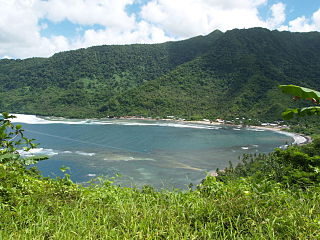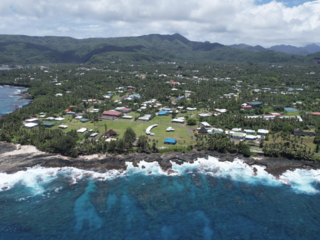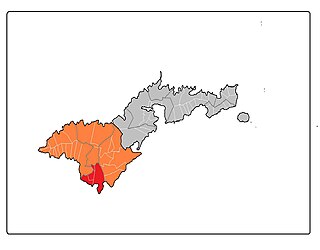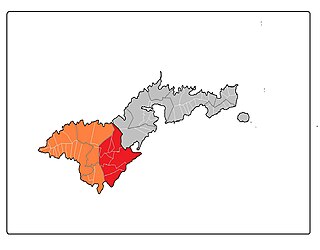Related Research Articles

Samoan is a Polynesian language spoken by Samoans of the Samoan Islands. Administratively, the islands are split between the sovereign country of Samoa and the United States territory of American Samoa. It is an official language, alongside English, in both jurisdictions. It is widely spoken across the Pacific region, heavily so in New Zealand and also in Australia and the United States. Among the Polynesian languages, Samoan is the most widely spoken by number of native speakers.

Taʻū is the largest inhabited island in the Manuʻa Islands and the easternmost volcanic island of the Samoan Islands. Taʻū is part of American Samoa. In the early 19th century, the island was sometimes called Opoun.
Marquesan is a collection of East-Central Polynesian dialects, of the Marquesic group, spoken in the Marquesas Islands of French Polynesia. They are usually classified into two groups, North Marquesan and South Marquesan, roughly along geographic lines.

Tutuila is the largest and most populous island of American Samoa and is part of the archipelago of the Samoan Islands. It is the third largest island in the Samoan Islands chain of the Central Pacific. It is located roughly 4,000 kilometers (2,500 mi) northeast of Brisbane, Australia and lies over 1,200 kilometers (750 mi) to the northeast of Fiji. It contains a large, natural harbor, Pago Pago Harbor, where Pago Pago, the capital of American Samoa, is situated. Pago Pago International Airport is also located on Tutuila. The island's land expanse is about 68% of the total land area of American Samoa. With 56,000 inhabitants, it is also home to 95% of the population of American Samoa. The island has six terrestrial and three marine ecosystems.

The Manuʻa Islands, or the Manuʻa tele, in the Samoan Islands, consists of three main islands: Taʻū, Ofu and Olosega. The latter two are separated only by the shallow, 137-meter-wide Āsaga Strait, and are now connected by a bridge over the strait. The islands are located some 110 kilometers east of Tutuila and are a part of American Samoa, an unincorporated territory of the United States. Their combined area is 56 square kilometers, and they have a total population of 1,400. Taʻu is the largest of these islands, with an area of 44 km2 (17 sq mi), and it has the highest point of the Manuʻa, at 931 meters. Politically, the islands form the Manuʻa District, one of the three administrative divisions of American Samoa.

Ātua is an ancient political district of Samoa, consisting of most of the eastern section of Upolu and the island Tutuila. Within Samoa's traditional polity, Ātua is ruled by the Tui Ātua together with the group of six senior orators of Lufilufi and 13 senior matai from throughout Ātua, comprising the Fale Ātua. The fono (meeting) of Atua's rulers takes place in Lufilufi on the great malae of Lalogafu'afu'a.

Vaʻa-o-Fonoti is a district on the north east coast of Upolu Island in Samoa, with a population of 1,621, making it the least populated district in the country and the Second smallest one by area after Aiga-i-le-Tai.
The meʻetuʻupaki is an ancient Tongan group dance, already reported by early European navigators like captain Cook. This dance has been traditionally designed for men although women may take part if there are not enough men. The meʻe tuʻu paki resembles a kind of war dance; albeit, it is done with little symbolic paddles as opposed to arms.
Fitiuta, also known as Fiti'uta or Maia, is a village on the northeast coast of Taʻū island, one of the Manuʻa Islands in American Samoa. As of the 2010 United States Census, it had a population of 153. The village of Fitiuta is made up of two hamlets: Maia and Leusoali'i, the latter of which is the most eastern area on the island. Historically, they were classified as villages. The town has two shops, a hotel and a church, which was recently built. Fitiuta Airport is located in the town.

Uafato is a village on the north east coast of Upolu island in Samoa within the political district of Va'a-o-Fonoti. It has a population of 254. The village is part of a conservation zone called the Uafato Conservation Area with national and global significance as a unique cultural and conservation area.

Leone is the second-largest city on Tutuila Island's west coast. The village is on the south-west coast of Tutuila Island, American Samoa. Leone was the ancient capital of Tutuila Island. Leone was also where the Samoan Islands’ first missionary, John Williams, visited on October 18, 1832. A monument in honor of Williams has been erected in front of Zion Church. Its large church was the first to be built in American Samoa. It has three towers, a carved ceiling and stained glass. Until steamships were invented, Leone was the preferred anchorage of sailing ships which did not risk entering Pago Pago Harbor. Much early contact between Samoans and Europeans took place in Leone.

Government House, also known as Building No.1, Naval Station, Tutuila or Government House, U.S. Naval Station Tutuila, is a historic government building on the grounds of the former United States Naval Station Tutuila in Pago Pago, American Samoa. Built in 1903, it has served as a center of government on the island for much of the time since then. Government House was listed on the United States National Register of Historic Places in 1972, and was declared a National Historic Landmark in 1990.

Aʻoloau is a village in the west of Tutuila Island, American Samoa. It is located inland, 5 miles (8 km) southwest of Pago Pago. It is also known as Aʻoloaufou, which means "New Aʻolou". An abandoned area in town by Aʻoloau Bay is known as Aʻoloautuai, which means "Old Aʻoloau". Aʻoloau's nickname is Nuu Puaolele which means the Fog Village.
Faleāsao is a village in American Samoa. It is located in Manu'a District, on the northern shore of Ta'ū Island. It is divided into two subvillages the eastern side being called Si'ua'i while the western half being called Tufulele (Tufu). The high chief is the Aso'au title currently in array for there is no known heir to the title.

George Pratt was a missionary with the London Missionary Society who lived in Samoa for forty years from 1839 to 1879, mostly on the island of Savai'i. Pratt was from Portsea, Portsmouth in England. He also served in Niue, the Loyalty Islands and New Guinea. In Samoa, Pratt lived at a mission station in Avao Matautu on the north coast of Savai'i island.
Samoan literature can be divided into oral and written literatures, in the Samoan language and in English or English translation, and is from the Samoa Islands of independent Samoa and American Samoa, and Samoan writers in diaspora. Samoan as a written language emerged after 1830 when Tahitian and English missionaries from the London Missionary Society, working with Samoan chiefly orators, developed a Latin script based Samoan written language. Before this, there were logologo and tatau but no phonetic written form.

Vailoatai is a village in southwestern Tutuila, the main island of American Samoa. It is located on the eastern end of Leone Bay. The village is known for its beautiful malae, nested along the island's rugged southern coast and lined by the fale tali mālō of its village chiefs.

Matafao Peak is a mountain in American Samoa, on the island of Tutuila. With an elevation of 653 metres (2,142 ft), it is the highest peak on Tutuila Island. The mountain, like Rainmaker Mountain across Pago Pago Harbor, is a remnant of a volcanic plug and is part of the volcanic origins of the island. The mountain can be hiked from the high point of the Pago Pago-to-Fagasa Road. It is designated a National Natural Landmark above the 492-foot (150 m) level, an area known as Matafao Peak National Natural Landmark.

Tuālā-tai County is one of the five counties that make up the Western District of American Samoa.

Tuālāuta County is a county in the Western District in American Samoa. It is the largest and also the most populated county in American Samoa. The county is represented by two seats in the Senate and two seats in House of Representatives in the American Samoa Legislature. 'Ili'ili is the principal place in Tualauta County, a county which consists of 'Ili'ili, Pava'ia'i, Mapusaga, Faleniu, Mesepa, Malae'imi, Tafuna, and Vaitogi.
References
- 1 2 Keesing, Felix Maxwell; Keesing, Marie Margaret (1956). Elite Communication in Samoa: a study of leadership . Volume 3 of Stanford Anthropological Series. Stanford University Press. p. 88 . Retrieved 16 January 2009.
Samoan oratory.
- ↑ Pratt, George. "Title: A Grammar and Dictionary of the Samoan Language, with English and Samoan vocabulary, NZ Licence CC-BY-SA 3.0". NZ Electronic Text Centre, Victoria University of Wellington. Retrieved 16 January 2009.
